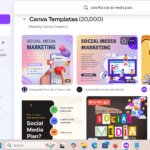The field of design is changing due to artificial intelligence (AI), which is making it more individualized, efficient, and intuitive than before. These days, designers use AI-powered technologies to increase creativity, automate tedious jobs, and push the envelope of what is feasible. However, how are the most recent developments in AI-powered design tools transforming the creative process?
1. Generative AI for Creative Design
One of the most exciting advancements is generative AI, which enables designers to create complex visuals, animations, and layouts with minimal manual input. Tools like DALL-E, MidJourney, and Runway ML allow designers to generate unique images, 3D models, and even videos from text prompts. These tools empower artists to explore countless variations in a fraction of the time traditionally required.
Key Features:
- Generate art, patterns, or textures with descriptive inputs.
- Explore creative directions with endless iterations.
- Reduce the time required for ideation and concept development.
2. AI-Enhanced UX/UI Design
AI tools are transforming the UX/UI design landscape by automating workflows and providing intelligent insights. Platforms like Figma and Adobe XD now integrate AI capabilities to optimise design layouts and suggest improvements based on user data.
Examples of Advancements:
- Content-Aware Layouts: Automatically adjust elements to create responsive designs.
- Accessibility Checks: Tools identify potential accessibility issues and suggest solutions.
- AI-Generated Prototypes: AI can now create interactive prototypes directly from hand-drawn wireframes.
3. Personalised Design Recommendations
AI-driven systems analyse user preferences, behaviour, and trends to offer personalised design recommendations. For example, Canva employs machine learning to suggest templates, fonts, and colour schemes tailored to specific projects.
4. Natural Language Processing (NLP) in Design Tools
By incorporating natural language processing (NLP) into design tools, designers may engage with software more organically. Users can express their needs in plain words rather than via traversing menus. Design platforms are integrating tools like ChatGPT and Jasper AI to increase productivity and streamline content creation.
Example Use Case: A designer could type, “Create a minimalist landing page for a tech startup” into an AI-powered tool, which would then generate a draft layout with appropriate visual elements.
5. AI in 3D Modelling and Animation
AI is making 3D modelling and animation more accessible to creators across industries. Software such as Blender now incorporates AI plugins to automate rigging, texture generation, and scene optimisation.
Key Features in 3D Modelling Tools:
- Automatic rigging of characters for animation.
- Generation of realistic textures based on input images.
- Simplified physics simulations for complex scenes.
6. Collaboration and Real-Time Editing
AI-driven tools enhance collaboration among creative teams. Features like real-time editing and predictive suggestions improve workflow efficiency.
Tools Leading the Way:
- Miro AI: Supports brainstorming with smart idea clustering.
- Figma: Enables seamless team collaboration with AI-powered design libraries.
- Adobe Sensei: Offers intelligent editing options and content suggestions.
7. AI for Typography and Branding
Typography and branding have greatly benefited from AI advancements. Tools like Fontjoy and Brandmark use algorithms to suggest type pairings, logos, and brand kits tailored to specific industries or target audiences.
8. Data-Driven Design Insights
Modern AI tools analyse data to provide actionable design insights. By examining user interactions, heatmaps, and behavioural patterns, these tools help designers optimise their creations for engagement and usability.
A Look at Some Popular AI-Driven Design Tools
| Tool | Purpose | Key Features | Example Use Case |
|---|---|---|---|
| DALL-E | Generative image creation | Text-to-image generation, customisable styles | Creating concept art for a marketing campaign. |
| Canva | Graphic design | Template suggestions, automatic resizing | Designing social media posts in minutes. |
| Adobe Sensei | Editing and enhancement | Content-aware fill, intelligent cropping | Enhancing photography for branding. |
| Figma | UX/UI design collaboration | Responsive design suggestions, interactive prototypes | Building app interfaces quickly. |
| Runway ML | Video editing and effects | AI-based rotoscoping, text-to-video | Creating visual effects for short films. |
| Fontjoy | Typography pairing | AI-suggested font combinations | Selecting typography for a modern website. |
9. Challenges and Considerations
Despite these advancements, there are challenges associated with AI-driven design tools:
- Creative Authenticity: Over-reliance on AI might limit genuine creativity.
- Learning Curve: Designers must adapt to new tools and workflows.
- Ethical Concerns: AI-generated content can raise copyright and originality questions.
- Data Privacy: Using AI tools often involves sharing sensitive project data.
10. Future Trends in AI-Driven Design
The future of AI in design promises exciting developments:
- Voice-Controlled Design Tools: Seamless voice commands for hands-free designing.
- Improved Realism in Generative AI: More lifelike textures and environments.
- Cross-Disciplinary Collaboration: Tools that bridge design, engineering, and marketing workflows.
- Sustainability Insights: AI tools that suggest eco-friendly design alternatives.
Conclusion
AI-driven design tools are transforming the creative process, empowering designers to work smarter and faster while exploring new horizons of creativity. From generative art to UX/UI design, AI continues to push boundaries, offering a blend of automation and inspiration. As these tools evolve, designers must stay informed and embrace change to unlock the full potential of AI in design.


